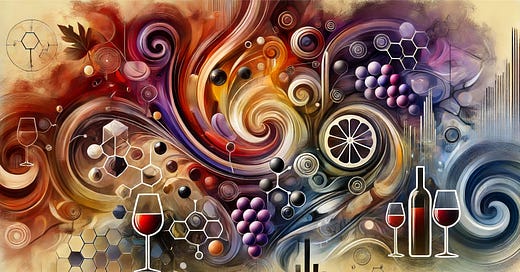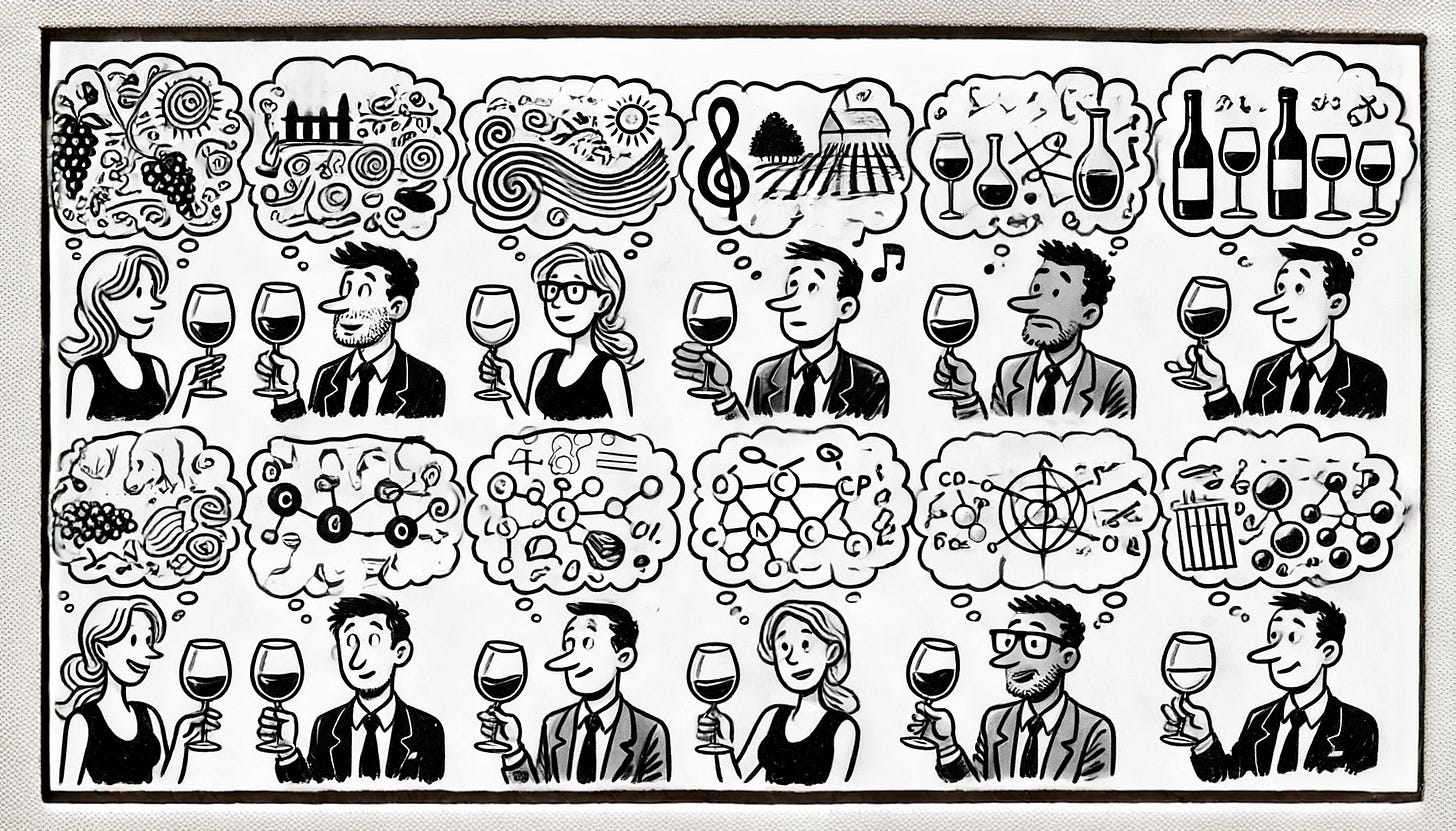NAPA VALLEY, Calif. — “This cabernet is soft and rich.”
“I’d say it’s dark and concentrated.”
There’s not a great deal of difference between hyperbole and euphemism, and the words we use to describe wine can be a little of each, or they can be so illusory as to be vague. Moreover, there are several substitute words and phrases that make describing wine about as mystical as making it. Which is one reason why the two statements above give very similar impressions using completely different terms.
And the impression that both of the above statements leave us with remains vague. Both fail to describe with much specificity what kind of a wine is being discussed. While most people would say the two descriptions point to a red wine that both reviewers liked a lot, the two descriptions define a red wine I would probably dislike.
How we describe wines, especially those we consider to be excellent, can be either lyrically poetic or rigidly scientific. Or they can be pure fantasy, using simile, allegory, metaphor or all of these. And how detailed a particular description is usually implies the writer’s enthusiasm for the product. Lots of words usually imply appreciation.
Of course, some wines are so bad that the reviewer is inclined toward disrespectful remarks that can be almost scatological or are intended to evoke laughter. As a writer and wine reviewer, I can say that writing negative reviews is always a lot more fun than writing positive ones.
However, writing really positive reviews can give smitten reviewers an opportunity to unleash a flood of encomiums that may be far in excess of what any wine-lover needs or desires. One example will suffice.
In the early 1980s the wine columnist for a Philadelphia newspaper described a white Burgundy he had tasted. It was a pricey Meursault. And this was no mere infatuation. He was in love. The review was at least 150 words long and made references to roasted hazelnuts, scents of a forest on a summer evening, the soil, some herbs and minerals, and allusions to specific emotional experiences that he admitted were difficult to explain in words. Thankfully he didn’t try.
It was obvious, however, that he loved the stuff. I don’t recall him using any terms to suggest whether this Meursault was prototypical of the French district of Meursault. He must have assumed that his readers were familiar with its district’s wines and knew how an archetypal Meursault smelled and tasted.
But how many people really appreciate wading through a thicket of 150 words before getting to the conclusion? Most Americans today live in the fast lane and prefer to know whether a wine is worth 96 points or 97. For people who understand how wines are scored, either number is all they need. (I do not understand anything about the scoring of wines, so I cannot explain it.)
If a wine is expensive and a potential buyer has just decided that he or she is willing to part with that amount of money to get a bottle of it, I suspect that a one-point difference won’t change the buying decision. And if the wine is out of a buyer’s price range, the 150 words will be ignored.
In creating a tasting note for a wine that has relevance for most consumers, I always consider the nature of the words I use. I try to get to the heart of the message as quickly as I can using few words that are understood by most people who are still reading after they see the number following the dollar sign. It doesn’t take much to describe most wines.
Of course, it helps when writing for an audience that has a bit of knowledge about wine. And when I’m writing about a common grape, such as cabernet sauvignon, I expect readers will know what I’m talking about when I say that the wine smells like cabernet — or doesn’t.
But in today’s world, where so few cabernets smell like cabernet, reviews can be tricky. Each grape variety has its own set of varietal aromas. When I refer to the classic aroma of, say, a gewürztraminer, most knowledgeable readers know that the wine should smell kind of like gardenias, carnations, linalool, plumeria and/or chamomile tea. Every now and then I get a whiff of ginger or nutmeg.
If I use specific descriptive terms, I’d never have to tell readers to react with either “I’d hock the Oldsmobile and buy it” or “Best used to clean your trailer hitch.”
Or I could simply say that a particular wine is a classic. But here we run into a dilemma. I should define the word “classic.” Before answering that, we first have to define the phrase “fine wine.” Fortunately, Eliza Dumais, writing last week in the London-based Decanter Magazine, said:
“What we have in mind when we talk about fine wine is European wine – French, maybe Italian, maybe Spanish. Even in the United States, a country not lacking in ego, European wines have long been hailed as the hallmark of quality.”
This is a standard way of describing how most Americans once routinely viewed what they thought was a fine or “classic” wine. It has long been believed here that European wines defined a classic.
We have traditionally defined such wines as those that typically were marked by moderate alcohols, decent if not excellent acidity, and aromas that are more earthbound and reflective of the areas from which the wines came. A quality Bordeaux was said to be Bordeauxlike. (Duh.)
This definition of regionality was perfectly appropriate in the past. Unfortunately, the use of the word “classic” has changed. In recent decades it has been used to define wines with more alcohol, more oak and usually a bit more of everything.
Comparing California wines to European models was far more valid in the 1970s, when this all worked perfectly well. In 1976, for instance, when California cabernets were pitted against top Bordeaux at the Judgment of Paris blind tasting, the assumption was that all the red wines on the table were relatively comparable. And they were.
Most California winemakers of the earlier era used Bordeaux as a model, which is one reason that California cabernets then aged so beautifully — Bordeaux wines throughout history aged well, too.
Today, however, that has changed radically, partially as a result of the impact of scoring wines by numerical means. “Bigger,” more concentrated and extracted wines always got higher scores. Subtlety has not won the day in decades. Now most California red wines, irrespective of grape variety, are being produced with more intensity, density and far less of an homage to European “classics.”
In fact, many European wines have become “California-ized.” Look at Spanish reds, Chiantis or Côtes du Rhônes. Are all of them under 14% alcohol the way they all once were? Alas, many are now above 15%. For at least a decade these wines have been made with far more alcohol than they ever were in their earliest years, when they were more prototypical of their regions and represented the “classics” we referenced.
With so many newcomer wine-buyers demanding wines of instant “tastiness,” most California wines no longer are made with the same kind of balance, structure or good acidity they previously always displayed. And the higher the alcohol level a wine has, the less likely it is to work with food.
So much for our ability to use the word “classic” to refer to either most French or California wines. Thus has the terminology changed that we use today to describe wine.
In the past, each of the greatest wines of Europe was described by a set of terms that seemed unique to the separate wines we had come to revere. Some of the best examples are wines from Barolo, Chablis, Montrachet, Chinon, Chianti, Muscadet, Germany (riesling), Austria (Grüner Veltliner), Spanish sherry, Pouilly-Fumé, Hermitage, Cote-Rotie, Sauternes, Champagne, Madeira, Port, Franciacorta (sparkling wine) and a dozen more.
The list of wine classics goes far beyond Europe and includes Coonawarra and Margaret River (cabernets, Australia), Clare or Eden valley (riesling, Australia), Hunter Valley (semillon, Australia), Central Otago (pinot noir, New Zealand), Constantia (South Africa), Tokaji Aszu Eszencia (Hungary). And the list continues.
(Australia, and New Zealand, which have their own unique wine cultures, are relatively immune from changes in wine styles. Each of those Down Under countries has its own unique wine-collector community that has always shown tremendous support for the styles of wine they best produce.)
To compare a superb example of a domestic wine with the original “classic” Euro regions ought to be seen as a compliment and a credit to the domestic grape-grower as well as the winemaking team that produced it. Each of these wines has its own unique set of descriptors, some of which overlap. But in most cases the greatest characteristics are those that regularly are seen in the most exemplary versions.
Atypical examples of wines that are compared with the classics are a tipoff that the reviewer might have missed the notion of what a classic wine is. For example, if a young California chardonnay that a reviewer adores is described as “Chablis-like” and he or she also uses a word like “succulent” in that review, something is very wrong.
A great young Chablis is almost never described as succulent. “Crisp?” Sure. “Tart?” Yes. Minerally? Probably. This particular wine has its own unique persona. I cannot imagine any decent reviewer loving a young Chablis-like wine that he or she describes as instantly delicious. Such wines are intended to go with food or be aged in a cellar.
And here we get to descriptions that recently have become popular with some people who think they know something about cabernet sauvignon.
Among the terms I have seen that referred to greatness in a California cabernet are words such as soft, succulent, concentrated, massive, powerful, extracted, chocolatey, luscious, mouthwatering, delicious and a dozen more. What was left unsaid were words that were equally appropriate and also might be applied to more reserved wines that also display greatness.
This includes words like balanced, beautifully structured, authentic, characterful, personality-driven, harmonious, distinctive, poised, composed, rewarding and historic.
By contrast, I saw a far more meaningful review recently that said a particular wine was full of “red roses, licorice, cassis, blueberry compote and kirsch with a touch of tilled soil.” The review was still as enthusiastic about the quality of the product, but it gave the reader more specific clues regarding what to expect.
I’m not suggesting that a wine review ignore all enthusiastic but vague comments. But when we are talking about fine wine, I believe it is best to try to be more specific, which would better assist potential buyers to understand what to expect.
It’s one thing to appreciate weight and concentration in a red wine, such as the cabernet discussed above. That does not, however, automatically mean that alternative styles that are better balanced are not equally praiseworthy. I have often tasted wines that others scored well below 80 points that I found to be remarkably enjoyable because they went well with food.
A reviewer who misses a wine’s subtler elements should not detract from its otherwise intrinsic value.
If today’s story captured your interest, explore these related articles:
Dan Berger’s Wine Chronicles: The Evolution and Art of Winemaking
Dan Berger’s Wine Chronicles: How Wine Is Packaged Can Affect Its Quality
Dan Berger's Wine Chronicles: Aged Red Wines Are Still 'Fine'
Wine in Crisis: Navigating Prohibitionist Waves and Market Shifts
Dan Berger's wine chronicles: The evolution of wine in a warming world
Dan Berger has been writing about wine since 1975.








When did Hungary stop being part of Europe?
I really enjoy Dan's articles.